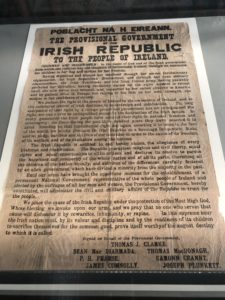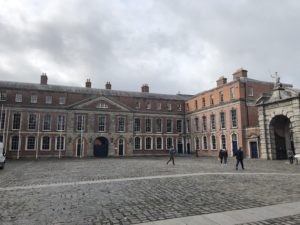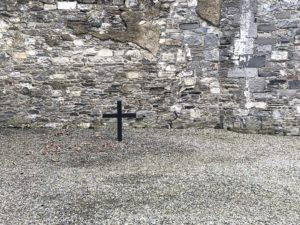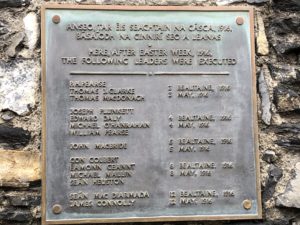Historical travel is one of the things I have missed the most since the pandemic began. My last major trip was to Dublin, Ireland in late February 2020. My daughter was studying abroad in Stockholm, Sweden and we decided to meet up in Dublin for a week. As we watched the news each evening the main story was about Covid quickly spreading through Italy. We were naïve to the fact that our lives would soon be turned upside down. We enjoyed the carefree tourist life while exploring and discovering Dublin for those seven days. As I reflect on that trip, I realize that nothing in life should be taken for granted. My time in Ireland also showed me just how the determination and will of a few can alter that direction of a country forever.
Irish history was something I knew a little about through a British history class I had taken, but this trip provided a greater understanding of their fight for independence. We learned a great deal about the 1916 Rising or Easter Rising through visits to various museums and sites in Dublin. The Easter Rising occurred between April 24-29, 1916, it was an attempt to overthrow British rule and create an independent Irish Republic. Irish independence and home rule had been a hotly contested issue for over 100 years between Ireland and Britain. In the years leading up to World War I, the possibility of home rule appeared to be a likely reality, which created various tensions and divisions between Irish unionists and nationalists. When World War I broke out, the Irish Parliamentary Party decided to postpone home rule efforts until after the war. This delay was seen by some as a lost chance at Irish independence and contributed to the planning of the Rising.

Three groups were behind the planning and carrying out of the Easter Rising – the Irish Republican Brotherhood (IRB), the Irish Volunteers, and the Irish Citizen Army (ICA). The IRB was the main strategist behind the Rising and the Irish Volunteers and ICA were the main fighting forces. The Rising was launched on Easter Monday, April 24, 1916, with the seizing of the General Post Office (GPO) in Dublin. From the steps of the GPO, Pádraig Pearse, the President of the Provisional Government of the Irish Republic read the Proclamation written by the planners. The Proclamation declared the establishment of an Irish republic and Irish independence. Elsewhere in the city, attempts were made to overtake Dublin Castle and the City Hall and the ICA occupied St. Stephen’s Green.

Initially, the British response to the insurgents was weaker than Rising planners had anticipated. The British had just 400 troops fighting approximately 1000 insurgents. Over the next several days fighting increased with various street battles occurring. Most surprising to some was the fact that over 200 women, many of whom were key players in the Rising, were involved in the fighting. As the week progressed, Britain sent reinforcements and by Friday, April 28 approximately 18,000-20,000 soldiers had arrived. These reinforcements were enough to put down the rebellion and on Saturday, April 29, Pearse surrendered along with the other insurgents. By the end of the week, 450 people were killed including 64 rebels, and 2164 were injured.
With the surrender of Pearse, nearly 100 rebellion leaders were arrested and tried by court-martial. The British government looking to make an example of them had the leaders sentenced to death and had 2000 rebels deported or sent to England. Fourteen men were killed by firing squad in the Stonebreakers’ Yard of Kilmainham Gaol. Including ICA leader James Connolly, who was so badly wounded that he initially was held at Dublin Castle, and later transfer to Kilmainham to be executed as he sat in a chair. Six other signers of the Proclamation were executed along with Connolly including Thomas Clark, Seán Mac Diarmada, Thomas MacDonagh, Patrick Pearse, Éamonn Ceannt, and Joseph Plunkett.

Following the execution of the leaders, the British government imposed martial law and made attempts to introduce conscription among Irish men to fight in World War I. These steps altered public opinion towards the British. This shift in public opinion helped give rise to a larger nationalist movement and the Irish War of Independence, which resulted in the Anglo-Irish Treaty in December 1921. An independent Irish Free State was officially formed on December 6, 1922, and later renamed Ireland. The men and women behind the Easter Rising helped ignite a larger movement that forever change Ireland.

Sources: A Pocket History of the 1916 Rising: The Story of Ireland’s Independence, edited by Fiona Biggs and Ruth Mahony, The Kilmainham Gaol Museum https://kilmainhamgaolmuseum.ie/, “Easter Rising 1916: Six days of armed struggle that change Irish and British history,” BBC, https://www.bbc.com/news/uk-northern-ireland-35873316, “Easter Rising: Topics in Chronicling America,” Library of Congress, https://guides.loc.gov/chronicling-america-1916-easter-rising

